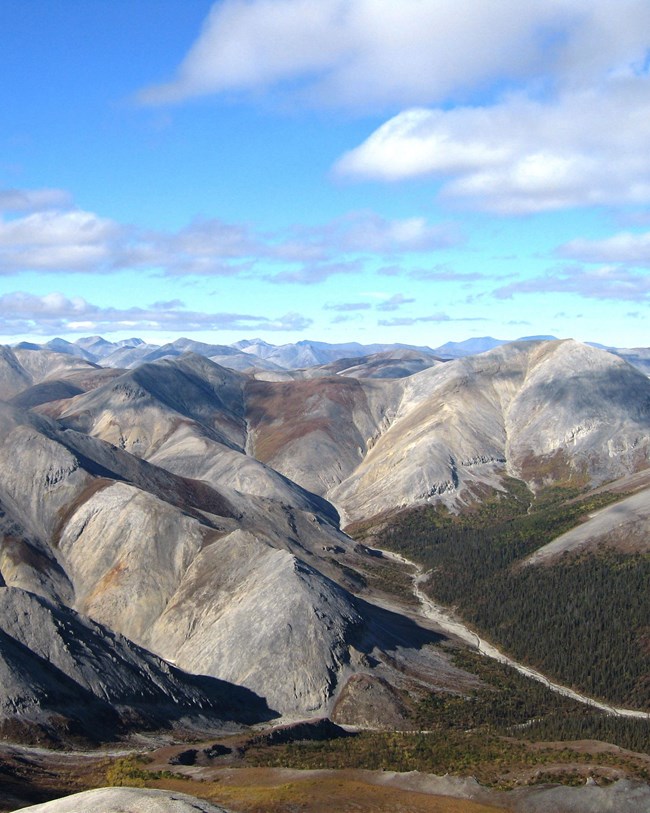Last updated: July 9, 2024
Article
NPS Geodiversity Atlas—Kobuk Valley National Park, Alaska
Geodiversity refers to the full variety of natural geologic (rocks, minerals, sediments, fossils, landforms, and physical processes) and soil resources and processes that occur in the park. A product of the Geologic Resources Inventory, the NPS Geodiversity Atlas delivers information in support of education, Geoconservation, and integrated management of living (biotic) and non-living (abiotic) components of the ecosystem.

Introduction
Kobuk Valley National Park (KOVA) is located 56 km (35 mi) north of the Arctic Circle in Northwest Arctic Borough, Alaska and shares its northern boundary with Noatak National Preserve. Originally established as a national monument on December 1, 1978, KOVA was redesignated a national park on December 2, 1980 (National Park Service 2016). The park encompasses about 708,489 hectares (1,750,716 acres) and protects the boreal forest and rivers of the central Kobuk River valley, the Great Kobuk Sand Dunes, and archeological resources such as Onion Portage. The Kobuk River bisects KOVA and has a cultural history dating back 9,000 years, as ancient civilizations would come to Onion Portage to harvest caribou.
Geologic Setting
The geologic history recorded in the rocks of Kobuk Valley National Park dates back more than 1 billion years to the Neoproterozoic, with some of the oldest units consisting of meta-sedimentary and meta-igneous rocks of Mount Angayukaqsraq. The northern portion of the park consists of an assemblage of Neoproterozoic–Devonian meta-sedimentary rocks, the Mississippian–Devonian Endicott Group, the Ordovician–Devonian Baird Group, and the Devonian Beaucoup Formation. Bedrock strata exposed in the southern region of KOVA include igneous rocks of the Mississippian– Early Jurassic Angayucham assemblage, Jurassic–Cretaceous mélange (a poorly sorted large-scale jumble of angular rock fragments) of the Arctic Alaska and Ruby terranes, and Cretaceous sedimentary rocks. Younger surficial deposits consist of Pleistocene to Holocene glacial and dune deposits, alluvium, and Holocene dune deposits of the Great Kobuk Sand Dunes. The Great Kobuk Sand Dunes, along with the smaller Little Kobuk Sand Dunes and Hunt River Sand Dunes, are a relic of the Ice Age. Fine-grained sand and silt that make up the dunes were originally deposited by glaciers that subsequently washed into the Kobuk River valley (National Park Service 2010).
- Scoping summaries are records of scoping meetings where NPS staff and local geologists determined the park’s geologic mapping plan and what content should be included in the report.
- Digital geologic maps include files for viewing in GIS software, a guide to using the data, and a document with ancillary map information. Newer products also include data viewable in Google Earth and online map services.
- Reports use the maps to discuss the park’s setting and significance, notable geologic features and processes, geologic resource management issues, and geologic history.
- Posters are a static view of the GIS data in PDF format. Newer posters include aerial imagery or shaded relief and other park information. They are also included with the reports.
- Projects list basic information about the program and all products available for a park.
Source: NPS DataStore Saved Search 2997. To search for additional information, visit the NPS DataStore.
A NPS Soil Resources Inventory project has been completed for Kobuk Valley National Park and can be found on the NPS Data Store.
Source: NPS DataStore Saved Search 3044. To search for additional information, visit the NPS DataStore.
Related Articles
Kobuk Valley National Park
National Park Service Geodiversity Atlas
The servicewide Geodiversity Atlas provides information on geoheritage and geodiversity resources and values within the National Park System. This information supports science-based geoconservation and interpretation in the NPS, as well as STEM education in schools, museums, and field camps. The NPS Geologic Resources Division and many parks work with National and International geoconservation communities to ensure that NPS abiotic resources are managed using the highest standards and best practices available.

